GIGA BYTE TECHNOLOGY GN-A15AG IEEE 802.11a+g Wireless Access Point User Manual
GIGA-BYTE TECHNOLOGY CO., LTD. IEEE 802.11a+g Wireless Access Point Users Manual
Contents
- 1. user manual part 1
- 2. user manual part 2
user manual part 1

GN-A15AG
Wireless Access Point
User Guide
Rev.1.0 First Edition
2
GN-A15AG Wireless Access Point User Guide
Federal Communication Commission Interference Statement
This equipment has been tested and found to comply with the limits for a Class B digital
device, pursuant to Part 15 of the FCC Rules. These limits are designed to provide rea-
sonable protection against harmful interference in a residential installation. This equip-
ment generates, uses and can radiate radio frequency energy and, if not installed and
used in accordance with the instructions, may cause harmful interference to radio
communications. However, there is no guarantee that interference will not occur in a par-
ticular installation. If this equipment does cause harmful interference to radio or television
reception, which can be determined by turning the equipment off and on, the user is en-
couraged to try to correct the interference by one of the following measures:
- Reorient or relocate the receiving antenna.
- Increase the separation between the equipment and receiver.
- Connect the equipment into an outlet on a circuit different from that to which the
receiver is connected.
- Consult the dealer or an experienced radio/TV technician for help.
FCC Caution: To assure continued compliance, any changes or modifications not expressly
approved by the party responsible for compliance could void the user’s authority to oper-
ate this equipment.
This device complies with Part 15 of the FCC Rules. Operation is subject to the following
two conditions: (1) This device may not cause harmful interference, and (2) this device
must accept any interference received, including interference that may cause undesired
operation.
IMPORTANT NOTE:
FCC Radiation Exposure Statement:
This equipment complies with FCC radiation exposure limits set forth for an uncontrolled
environment. This equipment should be installed and operated with minimum distance
20cm between the radiator & your body.
This transmitter must not be co-located or operating in conjunction with any other antenna
or transmitter.
The antenna(s) used for this transmitter must not be co-located or operating in conjunction
with any other antenna or transmitter
"GIGABYTE declare that GN-A15AG (IEEE 802.11a+g Wireless Access Point) is limited in CH1~CH11
by specified firmware controlled in USA."
GN-A15AG Wireless Access Point User Guide
3
Contents
Chapter1 Introduction.................................................................4
Overview......................................................................................................................... 4
Features............................................................................................................................4
Package Contents........................................................................................................... 5
The Rear Panel.................................................................................................................5
The Front Panel LEDs..................................................................................................... 6
Chapter 2 Installation...................................................................7
Hareware Requirements................................................................................................. 7
System Requirements..................................................................................................... 7
Internet Configuration Requirements............................................................................7
Hareware Installation..................................................................................................... 8
Connect to Access Point................................................................................................. 8
Illustration.........................................................................................................................9
Chapter3. Access Point Manager..............................................11
Installing the Access Point Manager.............................................................................. 11
Using the Access Point Manager................................................................................. 15
Upgrade Firmware......................................................................................................... 36
Uninstall AP Utility...........................................................................................................37
Chapter4 Web-Based Configuration Utility..............................39
Chapter5 Troubleshooting........................................................54
Appendix A: Glossary.................................................................56
Appendix B: Specification..........................................................59
Physical Interface.......................................................................................................... 59
System Specification....................................................................................................... 59
Appendix C: Configuration of the PCs.....................................60
The Setting under Windows 2000..................................................................................60
The Settings under Windows 95/98/Me......................................................................... 63
The Settings under Windows XP................................................................................... 66

4
GN-A15AG Wireless Access Point User Guide
Chapter1 Introduction
Overview
Features
nIEEE 802.11a & 802.11b/g compliant
nSupport Turbo A/G and Super A/G
nData rate up to 108Mbps
nDynamically scales the data rates
nAutomatic channel selection
nStrong security support --
64/128/152-bit WEP encryption
Wi-Fi Protect Access (WPA) with TKIP and AES encryption
802.1x RADIUS client
nDHCP client/server support
nTransparent Bridge between WLAN/LAN
nEasy configuration through Web or AP manager
nFriendly SNMP management support
nRoaming support
nWireless Distribution Services (WDS) support
nFirmware upgradeable
GN-A15AG is a dual-band wireless Access Point (AP) compliant to Standards IEEE 802.
11a and IEEE 802.11g with one external 10/100 Ethernet port. This product adopts the
direct sequence spread spectrum (DSSS) and Orthogonal Frequency Division Multiplex-
ing (OFDM) technologies to provide a very stable wireless communication quality and an
excellent signal receiver capability.
The GN-A15AG Wireless A+G Access Point contains two separate wireless connectivity
radio transceivers, which support all three popular wireless networking specifications. The
first transceiver uses the 2.4GHz radio band, supporting both the widely-used and inex-
pensive IEEE802.11b standard at 11Mbps, and the new, almost five times faster, IEEE802.
11g at 54Mbps. The second radio operates in the 5GHz band, and supports IEEE802.11a
networking, also at 54Mbps. Besides, the GN-A15AG can support IEEE802.11g turbo and
IEEE802.11a turbo, the data rates can up to 108Mbps. Since the two radios operate in
different bands, they can work simultaneously, blanketing your wireless zone with high-
speed bandwidth.
And with up to 152-bit WEP encryption, you can feel relieved that your wireless network
communications are private. Easy to set up and use, the GN-A15AG provide you the AP
Manager and Web-based Configuration utility.

GN-A15AG Wireless Access Point User Guide
5
The Rear Panel
The Access Point’s ports are located on the Access Point’s rear panel.
RJ-45, Auto-sensing for 10/100M Ethernet WAN connection
Initial reset (Init to factory default) and Hardware reset.
The power port is where you connect the power adapter.
nOne Ethernet WAN Port
nInit Bottom
nWireless antenna
One 2.4 GHz / 5 GHz Dual Band antenna
nPower
Package Contents
Before the installation procedures, please ensure the components are not damaged dur-
ing the shipping. The shipment of the GN-A15AG includes:
-One GN-A15AG Wireless Access Point
-One AC Power Adapter
-One Installation CD with the AP Manager and User Guide Soft Copy
-One User Guide
-Two embedded 802.11a and 802.11g Wireless LAN Card
Please contact your local distributor or authorized reseller immediately for any missing or
damaged components. If you require returning the damaged product, you must pack it in
the original packing material or the warranty will be voided.

6
GN-A15AG Wireless Access Point User Guide
The Front Panel LEDs
The Access Point’s LEDs display information about the Access Point’s status.
nPower
nWLAN1
(Green Light)
(Green Light)
nWLAN2
nLAN
OnThe 11a MiniPCI Card is plugged in.
Blinking Package transmit
(Green Light)
On 10/100 Mbps Network Connection
Blinking 10/100 Mbps Data Transmission Rate
(Green Light)
Blinking (Red light)The device is damaged or Booting.
Green LightBoot on.
OnThe 11g MiniPCI Card is plugged in.
Blinking Package transmit

GN-A15AG Wireless Access Point User Guide
7
Chapter 2 Installation
System Requirements
nA Computer with Windows, Macintosh, or Linux-based operating system.
nA Javascript-enabled web browser program which supports HTTP upIoads such as
Microsoft Internet Explorer or Netscape Navigator version 4.0 or above.
Internet Configuration Requirements
In order to connect your Access Point to the AP Manager, you will need the following
configuration parameters to configure the TCP/IP setting of your computer:
vStatic IP Address: 192.168.1. x (e.g, 2 ~ 253)
vSubnet mask: 255.255.255.0
vDefault Gateway: 192.168.1.254
Hareware Requirements
To use the Wireless Access Point on your network, each computer may need the
following requirements:
nAn installed 802.11a or 802.11b or 802.11g wireless adapter.
nAn Ethernet LAN switch or hub.
na wired RJ-45 Ethernet cable

8
GN-A15AG Wireless Access Point User Guide
Follow these steps to install the Wireless Access Point.
Hareware Installation
1.Choose a proper place for Access Point. In general, the best location is at the center
of your wireless coverage area, within line of sight to all wireless devices. Keeping
clear of metal obstructions and away from direct sunlight.
2.Place the Access Point in the desired location. Normally, the higher you place the
antenna, the better the performance will be. The antenna’s position enhances the
receiving sensitivity.
3.Attach one end of an RJ-45 Ethernet cable to the Access Point and attach the other
end to a network hub, switch, router, or patch panel (possibly on a wall).
4.Attach one end of the AC power adapter to the Access Point and the other end to a
power outlet. (Note: Only use the power adapter supplied by Gigabyte in the product
package. Using a different adapter may result in product damage.)
For the average home, signal range should not be an issue. If you experience low or no
signal strength in areas of your home that you wish to access, consider positioning the
Access Point in a location directly between the computers with wireless adapters. Addi-
tional Access Points can be connected to provide better coverage in rooms where the
signal does not appear as strong as desired.
Wired Ethernet Cable
Connect to Access Point
You can connect a Crossover cable from your computer’s Network card to the Access
Point without using a Network switch or hub.
Wireless Connection
If you are using the wireless connection, you can connect to the Access Point using the
Gigabyte Access Point Manager without a wired Ethernet cable.

GN-A15AG Wireless Access Point User Guide
9
Illustration
There are two installation mode for your reference as follow:
Method 1: Static IP address
If you are Not using a DHCP server in your network, you can configure the AP by connect-
ing to the computer directly.
PC(AP Manager) 192.168.1.x
DHCP (Disable)
192.168.1.1(default)
AP
1.You will need to assign a Static IP Address to the computer that you are using to
configure the Access Point on the same subnet.
For instance, the default IP address of the Access Point is 192.168.1.1 and the subnet
mask 255.255.255.0. You can enter IP address 192.168.1.20 (assuming that it is not
already assigned to another network device), subnet mask 255.255.255.0 to your
computer.
Note: If you need the instructions on how to do this, please refer to Appendix C,
“Configuration of the PCs”
2.Connect to the Access Point one by one and assign a static IP to each Access Point.
For example, 192.168.1.2 or 192.168.1.y, etc. (If the IP address of your network is
10.1.5.x then your Access Point can be assigned to 10.1.5.y.)
3.Make sure that every Access Point has a unique IP.
4.After all Access Points have been configured successfully, then you can use AP
Manager to control/monitor all Access Points network.
PC(AP Manager) 192.168.1.x
DHCP (Disable)
192.168.1.1 192.168.1.2192.168.1.y
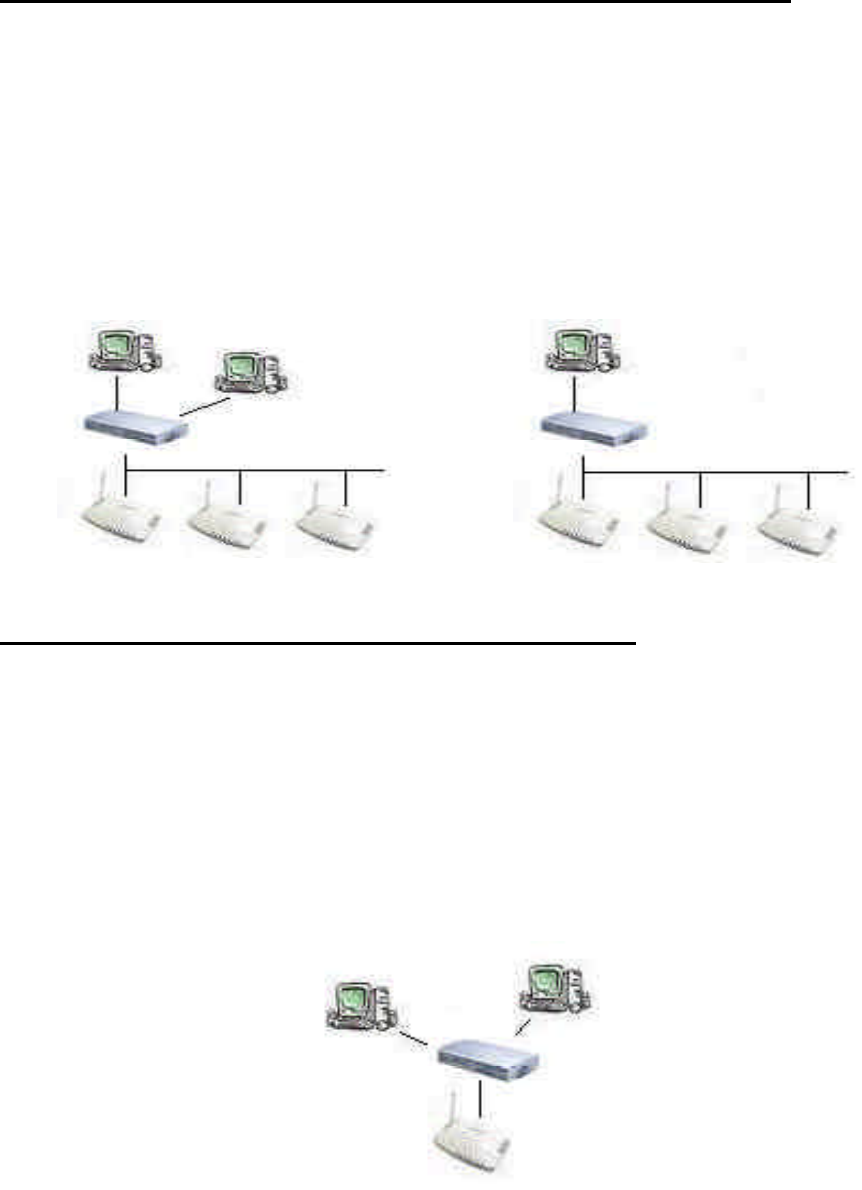
10
GN-A15AG Wireless Access Point User Guide
Method 2: Numerous Access Points setting
If require to setup as many Access Points at the same time. You can setup a DHCP Server
and let it assign IP to all the Access Points so it has its own unique IP address. After the
setup is finished, and then remove or disabled DHCP Server at last. Now, you can use the
AP Manager to find all Access Points in your network, and then setup the N-Access Points
as static IP address one by one. Notice: After assign static IP address to every Access
Points, be sure to set the PC (AP Manager) to the same subnet.
Using DHCP server to setup the IP Address then remove DHCP server
PC(AP Manager)
DHCP Server
Switch / Hub
PC(AP Manager)
Switch / Hub
e
Obtain IP Address Automatically - DHCP Server Enabled
If you are using a DHCP server in your network, you can connect a DHCP server with the
Access Point and an AP Manager through a switch/hub. The IP address of the Access
Point should be configured to “Obtain an IP address automatically” (which is default setting).
The DHCP server will assign the IP address to the Access Point. The PC (AP Manager)
should use the IP on the same subnet as the Access Point. Or, you can configure the PC
(AP Manager) to “Obtain an IP address automatically” and assign IP by the same DHCP
server.
PC(AP Manager) DHCP Server
Switch / Hub
AP
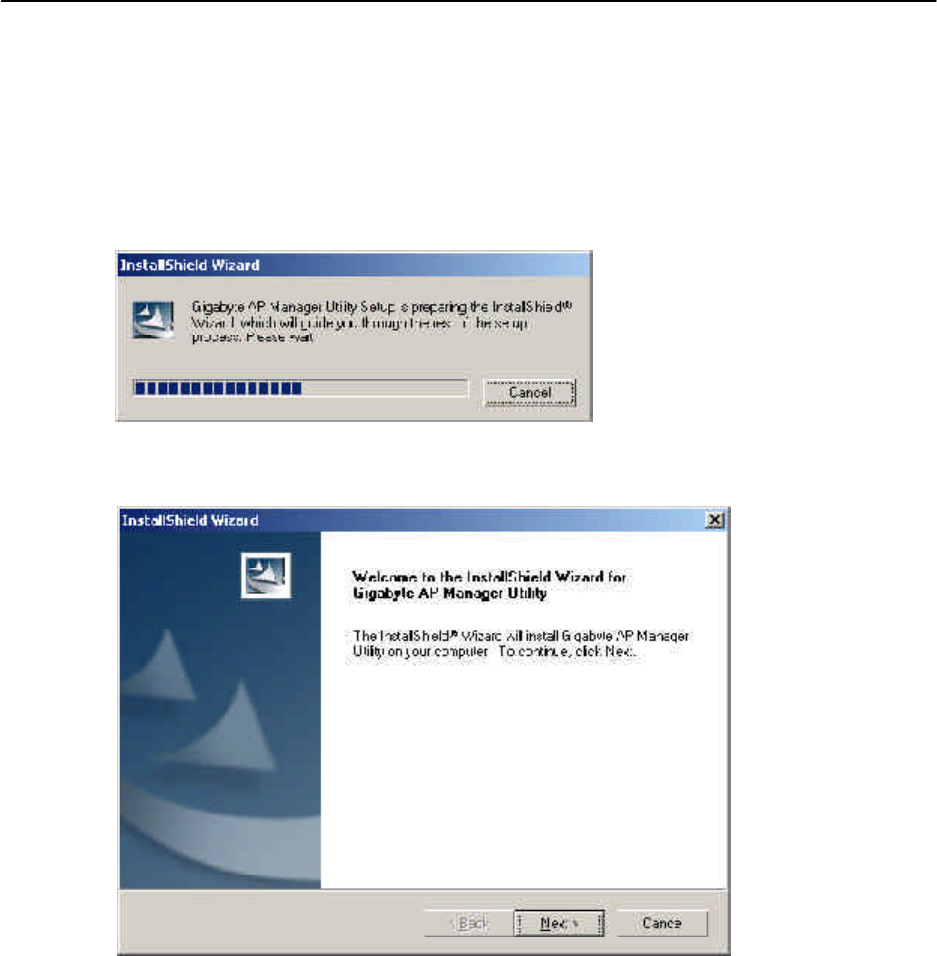
GN-A15AG Wireless Access Point User Guide
11
Chapter3. Access Point Manager
The Wireless Access Point can be configured one of two ways, through the AP Manager
Utility or the Web-based configuration Utility.The Gigabyte Access Point Manager is used
to configure Gigabyte Access Points.
Note: The performance of wire line link is better than wireless link between the AP
Manager and each Access Point. To use the wire line link to manage the
Access Point is recommended.
Installing the Access Point Manager
Please follow these steps to install the Gigabyte AP Manager in the Windows.
Step1. Insert the installation CD and click Install Gigabyte AP Manager on the CD
autorun screen.
Step2.Please wait a while!
Step3.Click “Next”.
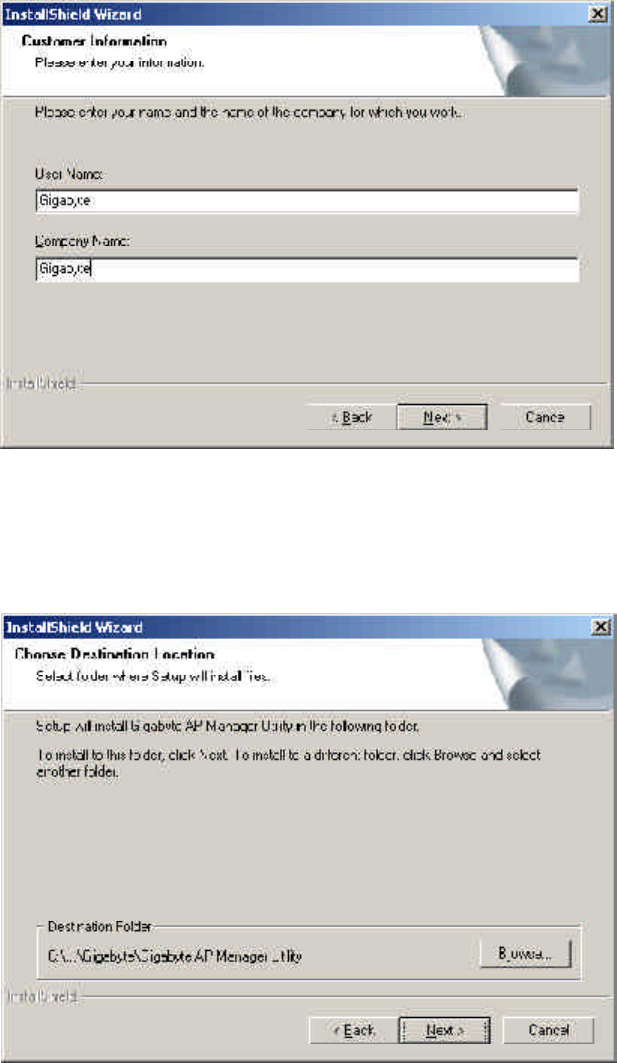
12
GN-A15AG Wireless Access Point User Guide
Step4.Type the User Information then click “Next”.
Step5.Click “Next” to accept the default directory or “Browse” to another location.
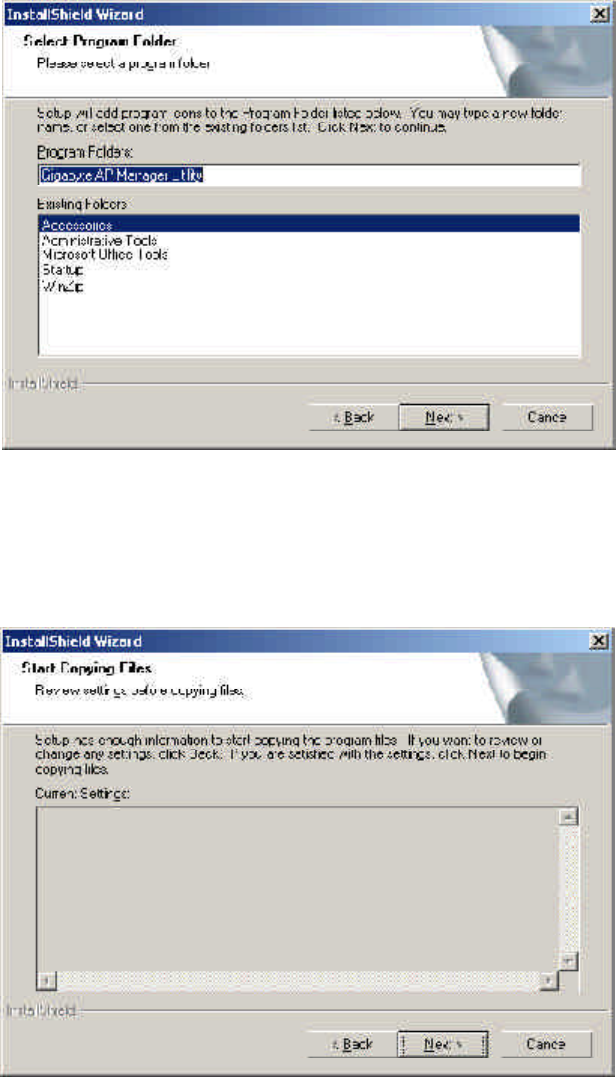
GN-A15AG Wireless Access Point User Guide
13
Step6.Click “Next”.
Step7.Click “Next”.
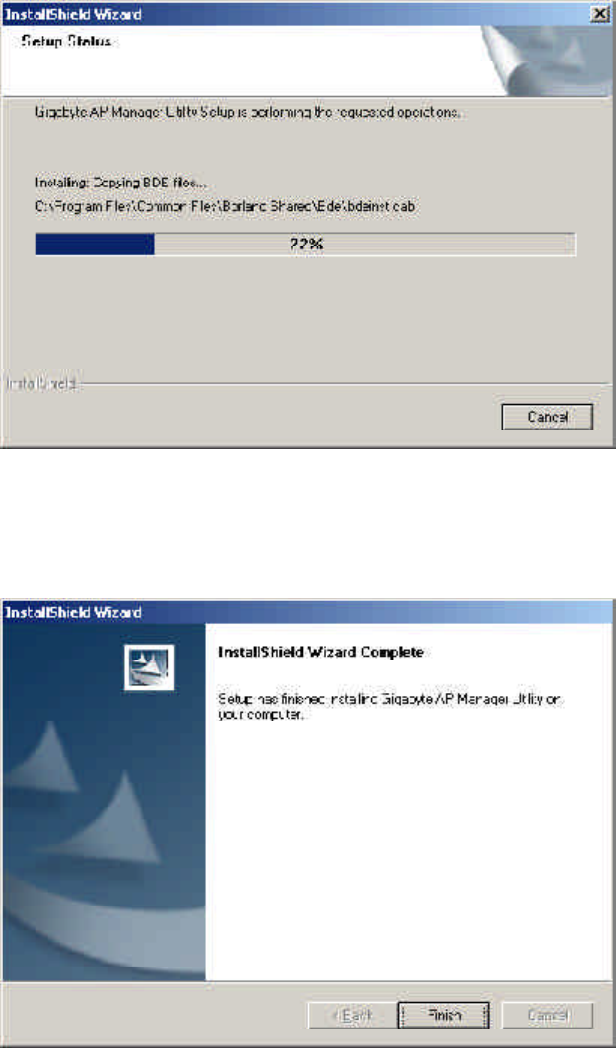
14
GN-A15AG Wireless Access Point User Guide
Step8.Please wait a while.
Step9.Click “Finish” to complete setup.
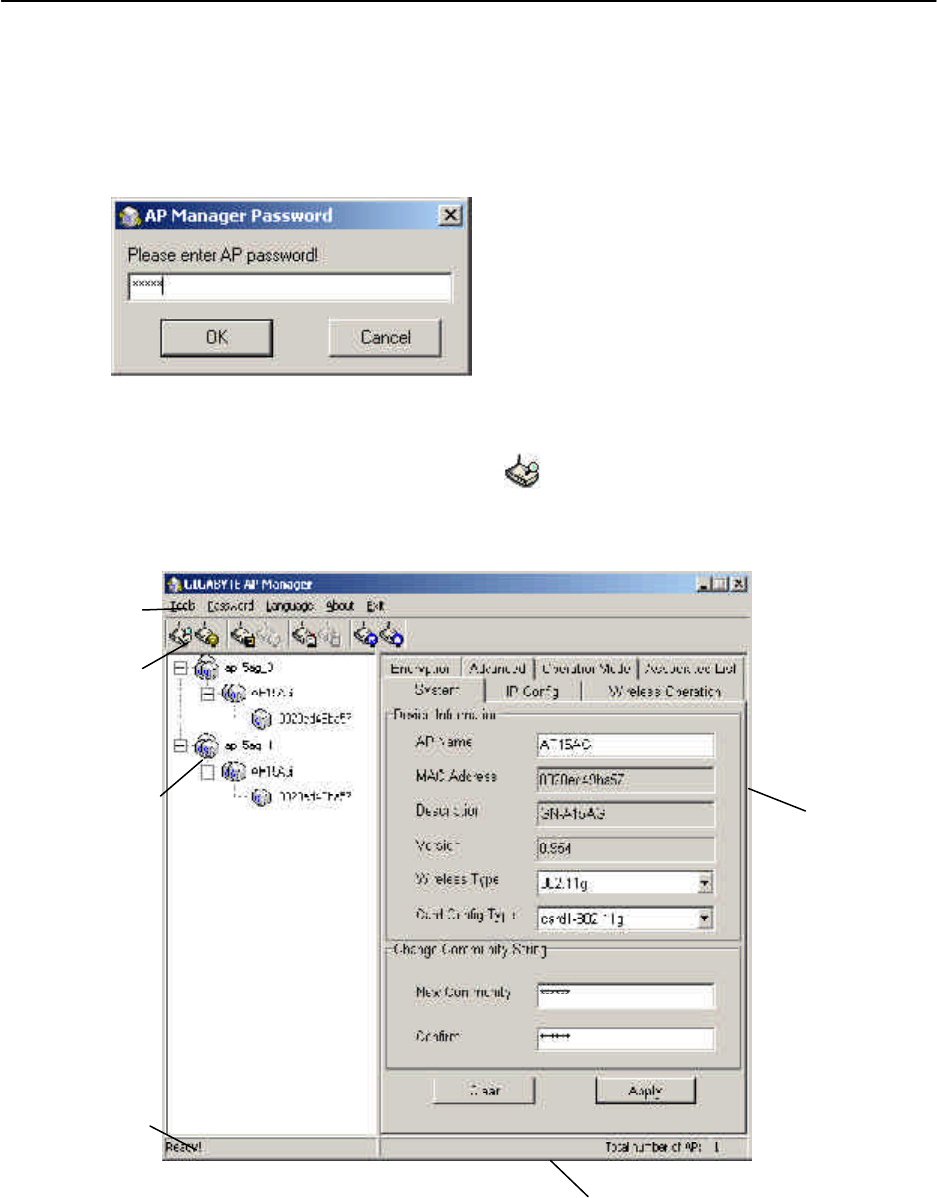
GN-A15AG Wireless Access Point User Guide
15
Using the Access Point Manager
You can launch Gigabyte AP Manager through Start \ Programs \ Gigabyte AP Manager
Utility \ Gigabyte AP Manager.
Enter the default password “admin” and click “OK” button.
It will automatically search for Access Points on the same subnet when you open the
Gigabyte AP Manager. You may click the icon to searching for Access Points
manually.
Menu bar
Tool bar
Tree view
Status bar
Page Control
Progress bar

16
GN-A15AG Wireless Access Point User Guide
nTree structure
ESSID (ap15ag_0)
AP Name (AP15AG)
MAC Address (0020ED001700)
nMenu bar
ToolsAllow you to “Search” for AP by ESSID, AP Name, MAC Address,
and IP Address and “Connect to AP by IP”. And allow you to “Save”,
“Load” the AP configuration and “Copy”, “Paste” the configuration
at the current page. Besides, it includes both “System Reboot” and
“Load Default”.
PasswordAllow you to change the AP Manager password and set the SNMP
community string.
AboutAn online help and the AP Manager version.
ExitExit the AP Manager.
Note: When you search for AP by AP Name (Tools->Search->By AP Name). You can
press the “search next” to continue to search the same name of AP.

GN-A15AG Wireless Access Point User Guide
17
nToor bar
Find Access Point
Save AP Configuration
Page Copy
System Reboot
Connect to AP by IP
Load AP Configuration
Page Paste
Load Default
Find all AP in the same subnet.
Save all setting of the AP to a temp file.
Load the setting of the temp file that you saved before to the current AP.
Copy the setting of the current page.
Paste the setting you has copied to the current page.(You can paste the setting
of AP1 to AP2 at the same tab page.)
Reboot the Access Point.
Set the Access Point to the manufacture default.
If you want to manage the AP in the different subnet, use this function and key
in the IP.
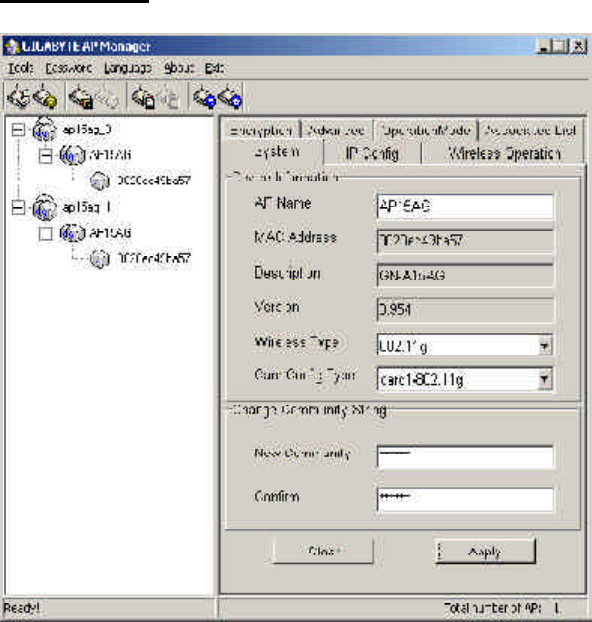
18
GN-A15AG Wireless Access Point User Guide
System Page
The System Page displays the Device Information and the Change Community String
function.
1Device Information
The Device Information include the AP name, MAC address, device description, the
version information and the device type.
2.Based on the “Card Config Type”, you can choose which wireless type you want
to use.
Note:
1)Please expand the Wireless Lan card when power off.
2)The embedded ”card1” support the IEEE802.11b/802.11g/802.11g turbo
standards and the “card2” can support IEEE802.11a/802.11a turbo
standards.
Recommending not to choose the Wireless-G type at the same time,
or it will be affect the performance of the Access Point.
1.You can change the AP Name to whateverunique name, which can represent
this AP.
3.The “Card Config Type” allows you to select which wireless card you want to
configure.

GN-A15AG Wireless Access Point User Guide
19
2.Please memorize the community string or write it down at somewhere.
In case you forget the community string, you have to press the AP init button and
then the AP setting (include community string) will be restore to default value.
Init bottom
Note: The SNMP community string defines the relationship between an SNMP manager
system (AP Manager) and the agent systems (all APs). This string acts like a pass
word to control the AP Manager to access the AP. The default value of the
community string is “public”. You can change the community string of AP Manager
by using Password->Set Community String on the Menu Bar.
1Change Community String
This function can let you change the community string to the AP. You can change a
new community string on purpose to prohibit other AP Manager access and manage
your AP. After you change the community string to AP, you need to do two following
actions.
1.Use Password->Set Community String on the Menu Bar to set the community
string to the AP manager. The AP Manager and the AP should have the same
community string. Otherwise the AP Manager will not be able to find the AP with
different community string
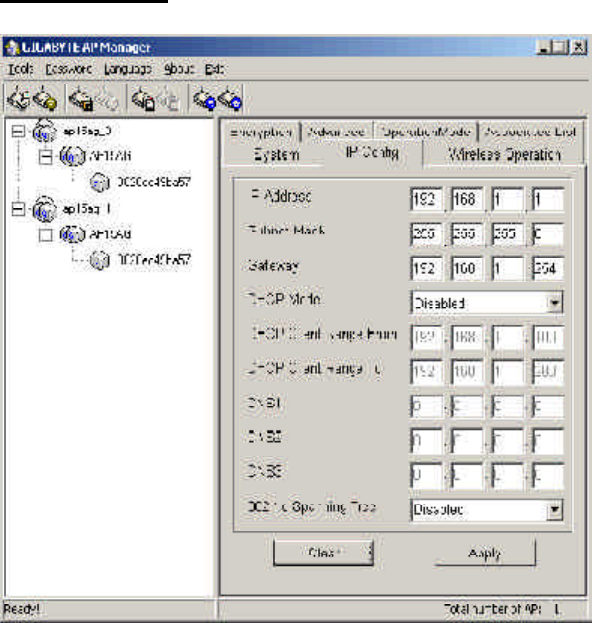
20
GN-A15AG Wireless Access Point User Guide
IP Config Page
The IP Configure tab allows you to configure the IP parameters of the access point.
1IP Address
1Subnet Mask
1Gateway
After you change the IP address of the AP, please also change the PC’s (AP Manager)
IP address to the same subnet. And then click the “Find Access Point” icon; AP
manager will search the AP on the network.
Enter the IP address of the default route. The default gateway is 192.168.1.254.
Specify the subnet mask of the access point. The default subnet mask is
255.255.255.0.
Use this option to assign an IP address to the access point. The default IP address
is 192.168.1.1. Please make sure the assigned IP address is unique on your
network.
GN-A15AG Wireless Access Point User Guide
21
If you want to get IP address from the DHCP server automatically on your network,
you will select “Client Enabled”. Or you want to use the Access Point as a DHCP
server to automatically assign dynamic IP address on the network, you will select
“Server Enabled”
1DHCP Client Range & DNS
If you select the “Server Enabled” setting, please input the IP address range and the
DNS for your network. The DNS information provied by your ISP company.
1802.1d Spanning Tree
Enabled or Disabled the 802.1d Spanning Tree function. The default setting is
Disabled.
Verify the desired setting and then click the “Apply” button to set the value into access
point.
1DHCP Mode
There are four settings under this option you can choose: “Disabled”, “Client
Enabled”, “Server Enabled” and “Auto”. Disabled is the default setting.
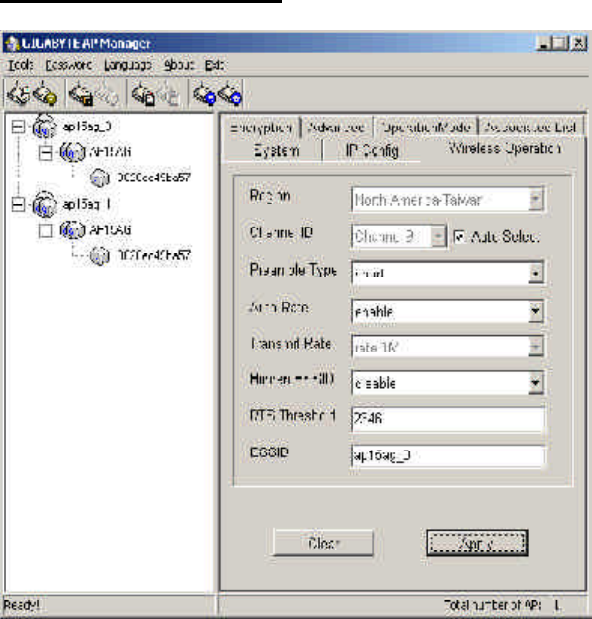
22
GN-A15AG Wireless Access Point User Guide
Wireless Operation Page
Normally, you can have the wireless works smoothly even you didn’t change any item in
this page.
1Region
Because of the different region has a different open channel regulation, please check
whether the default region value is your local area. If it did not appear properly region
please contact your local distributor or authorized reseller immediately.
1Channel ID
Please choose the channel, which you can get best performance. Normally, it doesn’t
need to change. The default setting is the “Auto Select” channel.
1Preamble Type
The preamble field shall be provided so that the receiver can perform the necessary
operations for synchronization. Under this option two setting are possible: “Long” or
“Short”. The default value is “Long”.
1Transmit Rate
You can select one of the rates among 1M, 2M, 5.5M, 11M, 6M, 9M, 12M, 18M, 24M,
36M, 48M, 54M based on your need. If the “Auto Rate” option is enable, it will not be
able to perform the “Transmit Rate” function.

GN-A15AG Wireless Access Point User Guide
23
1Auto Rate
In this item you can select either “enable” or “disable”. The default value is “enable”.
EnableIf the selection is “enable”, the transfer rate will automatically change to
the optimum rate allowed. The range of auto-change will base on the
setting of “Transmit Rate”.
DisableThere is no transfer rate auto-change. The transfer rate will be defined by
the “Transmit Rate” column.
1Hidden ESSID
This setting allows you to hide the ESSID in wireless transmission. Those who don’t
know the ESSID will not be able connect to the AP. The default value is “disable”.
1RTS Threshold
This value should remain at its default setting of 2346. Should you encounter
inconsistent data flow, only minor modifications are recommended. The setting range
is 0 ~ 2346.
1ESSID
The ESSID or SSID is the name represent the AP in the wireless network. The ESSID
of all AP in your network should set to identical for the mobile client can roam
between access points. This ESSID string is case sensitive of up to 32 ASCII
characters.
Verify the desired setting and then click the “Apply” button to set the value into access
point.
Note: The Data Rate of the 802.11b standard are 11M, 5.5M, 2M, 1M.
The Data Rate of the 802.11g turbo and 802.11a turbo can up to 108Mbps.
The Data Rate of the 802.11a standard are 6M, 9M, 12M, 18M, 24M, 36M, 48M,
54M
Transmit Rate setting:
54M: range is among 6M, 9M, 12M, 18M, 24M, 36M, 48M and 54M
48M: range is among 6M, 9M, 12M, 18M, 24M, 36M and 48M
36M: range is among 6M, 9M, 12M, 18M, 24M and 36M
24M: range is among 6M, 9M, 12M, 18M and 24M
18M: range is among 6M, 9M, 12M and 18M
12M: range is among 6M, 9M and 12M
9M: range is between 6M and 9M
6M: no auto-change. The transmit rate is fixed at 6M.
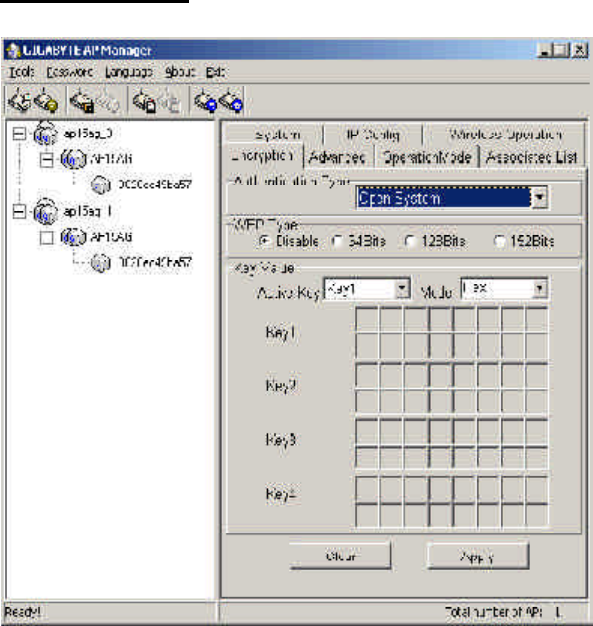
24
GN-A15AG Wireless Access Point User Guide
Encryption Page
1Authentication Type
Open Systemin which the sender and the recipient do NOT share a secret key.
Each party generates its own key-pair and asks the receiver to
accept the randomly generated key. Once accepted, this key is used
for a short time only. Then a new key is generated and agreed upon.
Shared Key is both the sender and the recipient share a secret key.
If the “Shared Key” and “Both” option is selected, it will not be able to perform the
option “disable” of the WEP Type.
This page is the security configuration of the wireless connection. Protects your informa-
tion with the highest level of industry-standard WEP encryption: 64/128-bit for 802.11b
standard, and up to 152-bit for 802.11g standards. When the “Disable” is selected there is
no WEP encryption. When “64bits”, “128bits” or “152bits” selected there is encrypted
date transfer to prevent unauthorized user to access the wireless network.
You may choose between “Open System”, “Shared Key”, “Both”, “802.1x -
Dynamic WEP”, “WPA”, “WPA-PSK”. The Authentication Type default is set to “Open
System”.
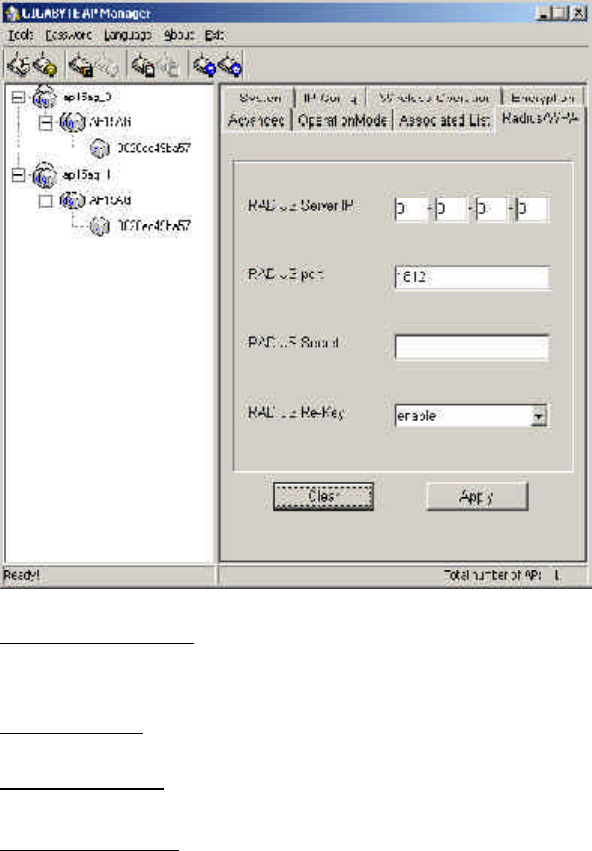
GN-A15AG Wireless Access Point User Guide
25
If the 802.1x – Dynamic WEP option is selected, the Radius/WPA page will appear
as shown below.
RADIUS server IP,Please assign a IP address to the primary RADIUS server
(authentication server).
RADIUS Port, The setting range is 1~65536 and the default value is 1812.
RADIUS sercet, This filed can key in up to 256 character.
RADIUS Re-Key,Under this option two setting are possible: “enable” or “disable”.
The default value is “enable”.
Verify the desired setting and then click the “Apply” button to set the value into access
point.
WPAif you have been using Wi-Fi for a while, you are probably familiar with the
802.1X authentication protocol. This protocol allows users to authenticate
into a wireless network by means of a RADIUS Server. In standard Wi-Fi,
802.1X authentication is optional. However, 802.1X authentication is a
requirement for WPA. If your environment does not have a RADIUS server
in place, you can still use WPA in spite of the 802.1X requirement. As an
alternative to RADIUS, WPA supports the use of a preshared key.

26
GN-A15AG Wireless Access Point User Guide
AES (Advanced Encryption Standard), A standard, sponsored by the
National Institute of Standards and Technology, for protecting data
through encryption. AES supports key sizes of 128 bits, 192 bits and
256 bits and will serve as a replacement for the Data Encryption
Standard (DES), which has a key size of 56 bits. In addition to the
increased security that comes with larger key sizes, AES can
encrypt data much faster than Triple-DES, a DES enhancement that
which essentially encrypts a message or document three times.
One of the biggest drawbacks to traditional WEP security is that
changing the encryption key is optional. Even ifyou do switch
encryption keys from time to time, there isno option for globally
rekeying all access points and all wireless NICs.
Instead, rekeying is a tedious manual process and is completely
impractical for large organizations. After all, the instant you rekey an
access point, none of the clients will be able to access it until they
are also rekeyed.
But with WPA, the rekeying of global encryption keys is required. In
the case of unicast traffic, the encryption key is changed after every
frame using Temporary Key Integrity Protocol (TKIP). This protocol
allows key changes to occur on a frame by frame basis and to be
automatically synchronized between the access point and the
wireless client. Global rekeying works by advertising the new keys to
wireless clients.
The TKIP is really the heart and soul of WPA security. TKIP replaces
WEP encryption. And although WEP is optional in standard Wi-Fi,
TKIP is required in WPA. The TKIP encryption algorithm is stronger
than the one used by WEP but works by using the same hardware-
based calculation mechanisms WEP uses.
The TKIP protocol actually has several functions. First, it determines
which encryption keys will be used and then verifies the client’s
security configuration. Second, it is responsible for changing the
unicast encryption key for each frame. Finally, TKIP sets a unique
starting key for each authenticated client that is using a preshared
key.
WPA PSKWPA use of a preshared key.
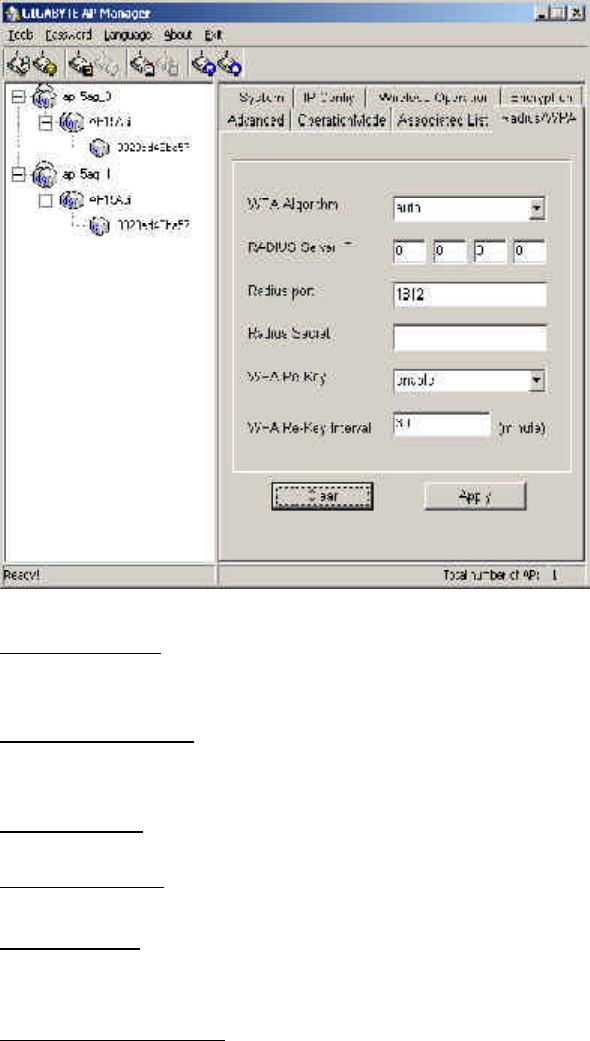
GN-A15AG Wireless Access Point User Guide
27
When WPA option is selected, the Radius/WPA page will appear as shown below.
WPA Algorithm,There are three settings you can select : “TKIP”, “AES”
and “Auto”.
RADIUS server IP,Please assign a IP address to the primary RADIUS server
(authentication server).
RADIUS Port, The setting range is 1~65536 and the default value is 1812.
RADIUS sercet, This filed can key in up to 256 character.
WPA Re-Key,Under this option two setting are possible: “enable” or
“disable”. The default value is “enable”.
Verify the desired setting and then click the “Apply” button to set the value into access
point.
WPA Re-Key Interval,Enter a Rekey Interval (normally the unit is seconds).
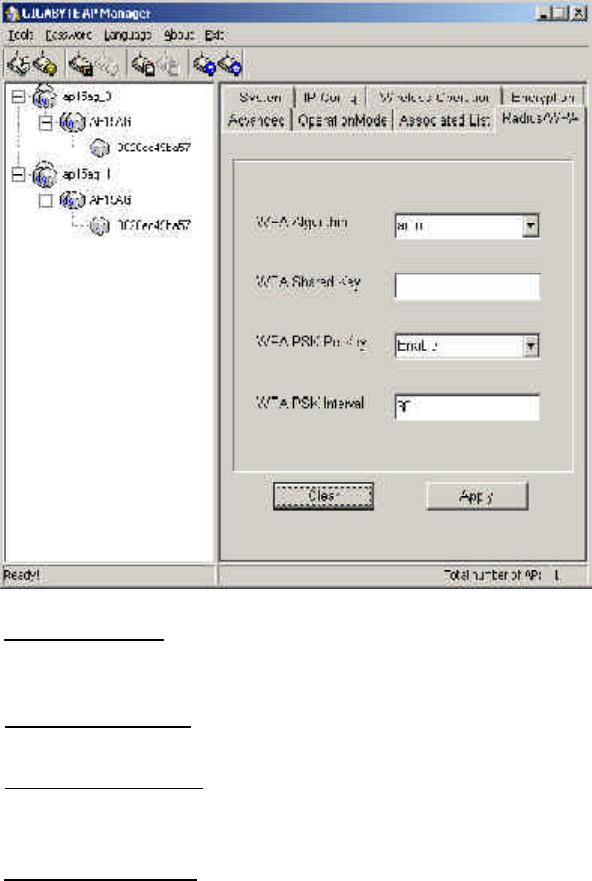
28
GN-A15AG Wireless Access Point User Guide
When WPA PSK option is selected, the Radius/WPA page will appear as shown
below.
WPA Algorithm,There are three settings you can select : “TKIP”, “AES” and
“Auto”.
WPA Shared Key,This filed can key in up to 256 character.
WPA-PSK Re-Key,Under this option two setting are possible: “enable” or
“disable”. The default value is “enable”.
WPA PSK Interval,Enter a Rekey Interval (normally the unit is seconds).
Verify the desired setting and then click the “Apply” button to set the value into access
point.
GN-A15AG Wireless Access Point User Guide
29
164 (40) Bits, 128 (104) Bits or 152 (128) Bits
There are three levels of encryption 64 bits, 128 bits and 152 bits. The 64 bits
encryption is referenced as a lower level encryption. The 152 bits encryption is
referenced as a higher level encryption.
The 64 bits WEP encryption use 40 bits as a secret key, which can controlled by
user, and 24 bits as the initialize vector, which user can not control. These two
portions plus together is 64 bits encryption. Some other vendor’s product might refer
as 40 bits encryption. It is the same thing.
The 128 bits WEP encryption use 104 bits as a secret key, which can controlled by
user, and 24 bits as the initialize vector, which user can not control. These two
portions plus together is 128 bits encryption. Some other vendor’s product might
refer as 104 bits encryption. It is the same thing.
The 152 bits WEP encryption use 128 bits as a secret key, which can controlled by
user, and 24 bits as the initialize vector, which user can not control. The 152 bits
WEP encryption spawns a KEY ID containing 32 HEX digits.
Verify the desired setting and then click the “Apply” button to set the value into access
point.
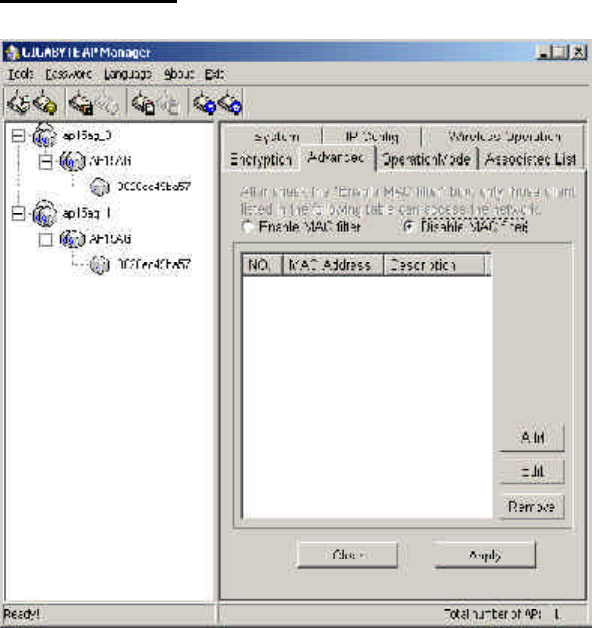
30
GN-A15AG Wireless Access Point User Guide
Advanced Page
For enhance the security of the wireless network, this AP provide the MAC address filter-
ing mechanism to prevent the unauthorized user access. Check “Enable MAC filter” and
key in MAC address table, then only those MAC address in the table are allowed to con-
nect to this AP.
1Enable MAC Filter
Choose the “Enable MAC Filter” and click the “Add” button to add more MAC
addresses or click “Remove” button to delete the MAC addresses from the
Authorized MAC Address table. Besides, you can click “Edit” button to edit the MAC
address.
1Disable MAC Filter
The default is “Disable MAC filter”.
Verify the desired setting and then click the “Apply” button to set the value into access
point.
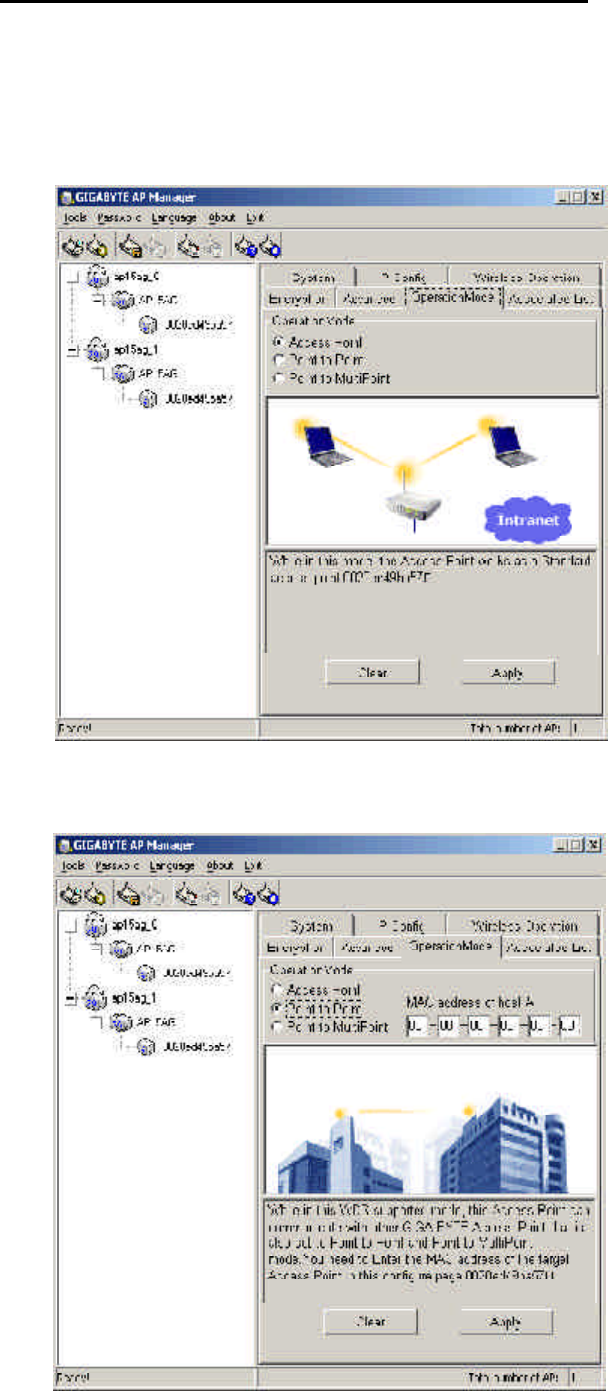
GN-A15AG Wireless Access Point User Guide
31
WDS (Wireless Distribution System) OperationMode
The Access Point supports three operation modes: “Access Point”, “Point to Point”, “Point
to MultiPoint”. The default operation mode is “Access Point”.
1Access Point
The operational mode is set to
Access Point by default. This
connects your wireless PCs to
a wired network. In most
cases, no change is
necessary.
1Point to Point Mode
In this WDS supported mode,
the Access Point can
communication with other
GIGA-BYTE Access point
which is also set to Point to
Point and MultiPoint mode.
You have to enter the MAC
address of the host AP.
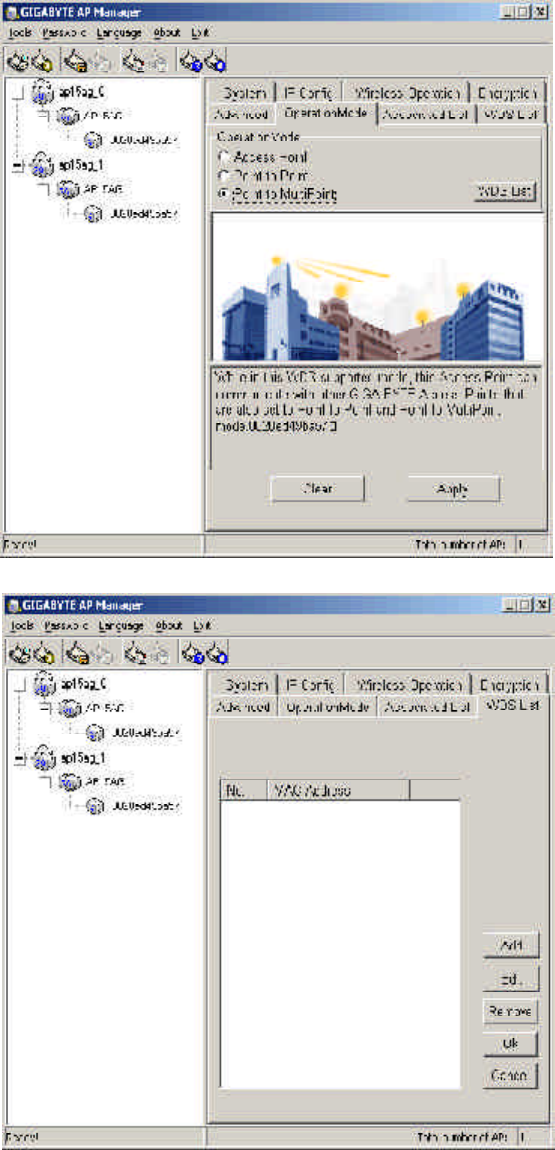
32
GN-A15AG Wireless Access Point User Guide
1Point to MultiPoint Mode
In this WDS supported mode,
the Access Point can
communication with other
GIGA-BYTE Access point
which is also set to Point to
Point and MultiPoint mode.
Click the “WDS List” button, it
will go to the WDS List page.
The maximum number of the connectible Access Point is 8.
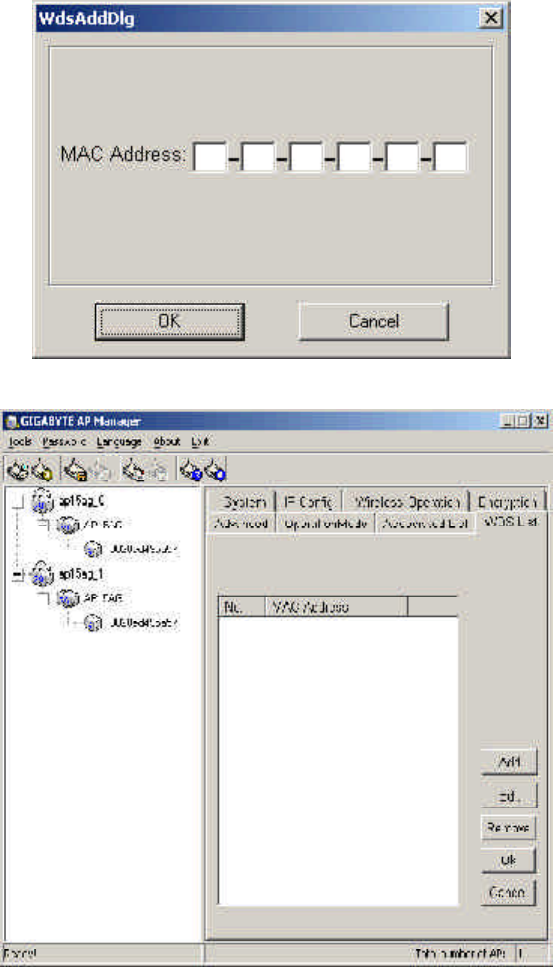
GN-A15AG Wireless Access Point User Guide
33
Click “Add” button, the Scan
Window will appear. Please
enter a MAC address to add
MAC Address into WDS List.
Besides, you can click “Edit”
button to modify the MAC
address which you select on
the WDS List or click
“Remove” button to delete the
MAC address which you select
on the WDS List. Or you can
click the ”Cancel” button to
reserve the original value.
Finally, please click “OK”
button to return to the
OperationMode page and click
“Apply” button to set the value
into access point.
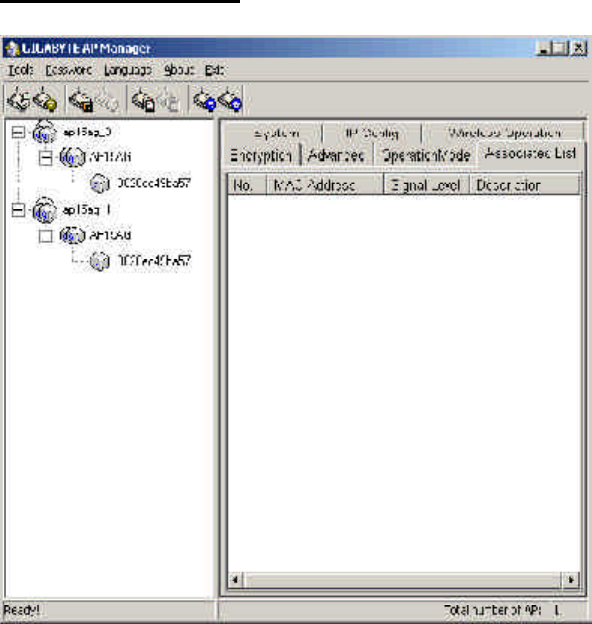
34
GN-A15AG Wireless Access Point User Guide
Associated List Page
From this page, you will get the information of the workstation which can connect to the
AP. The form list includes the MAC Address, Signal level and description of the workstation.
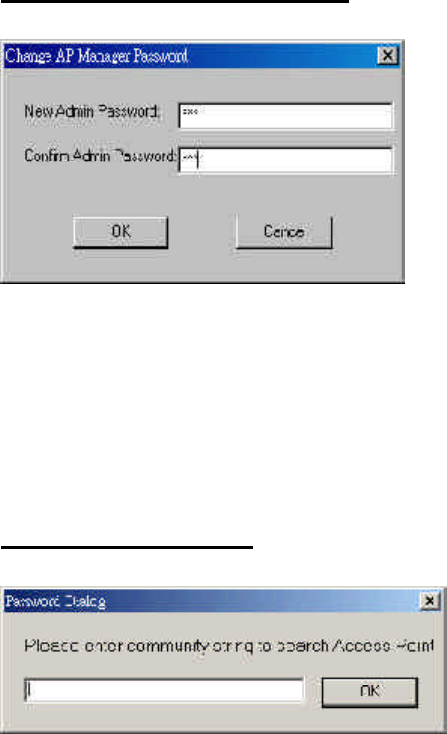
GN-A15AG Wireless Access Point User Guide
35
Change AP Manager Password
User can change the administration password of the AP manger to prevent other user
access to the AP Manager. On the Menu Bar (Password->AP Manager Password) can
invoke the password change dialog. Please enter a new admin password and confirm
admin password then press “OK” button. You have to enter this new password to log in
when you want to use the AP Manager next time.
Set Community String
The community string defines the relationship between AP manager and the AP. This
string acts like a password to control the AP Manager to access the AP. For detail description,
please refer to “System Page” section.
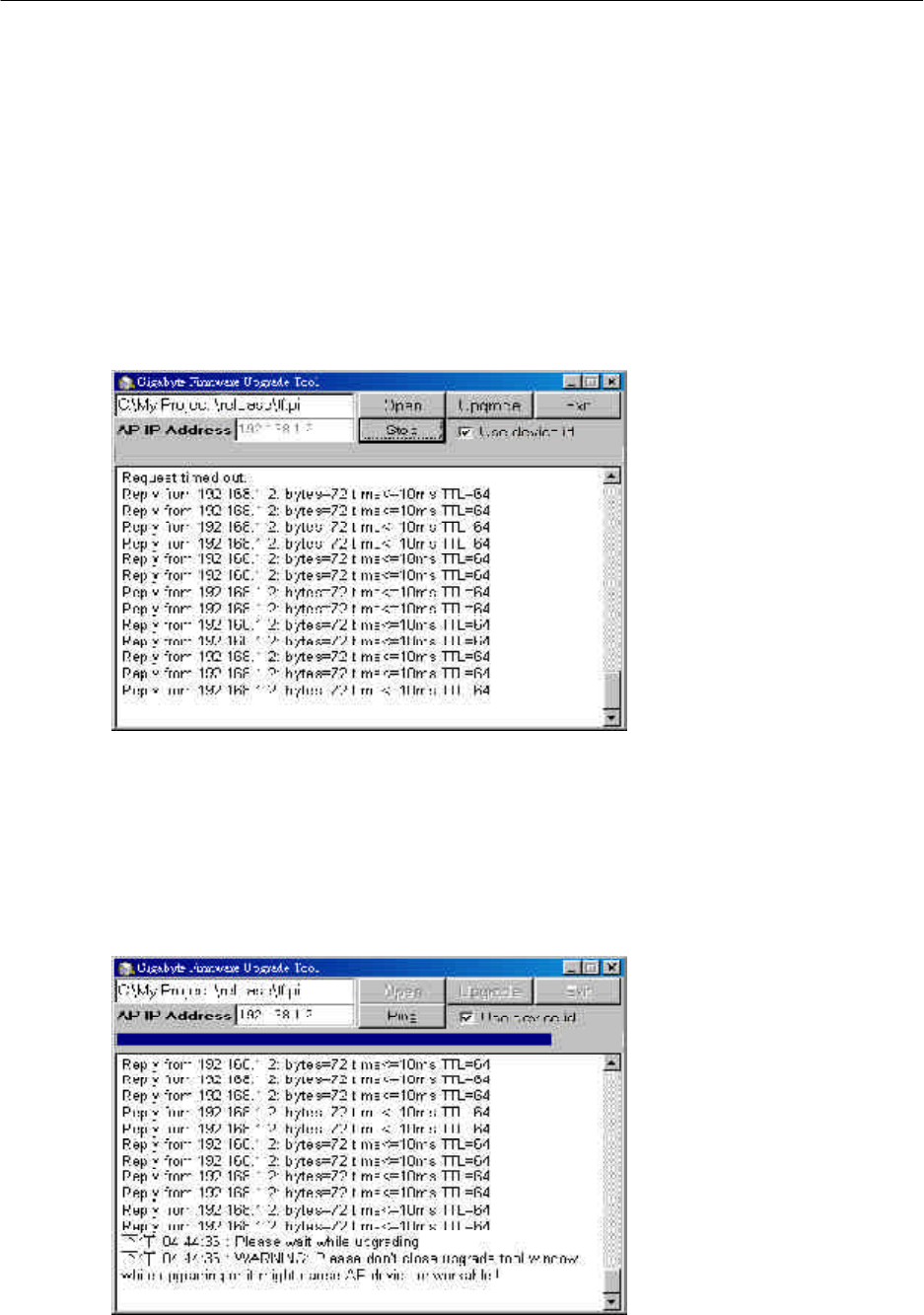
36
GN-A15AG Wireless Access Point User Guide
Upgrade Firmware
You can download the upgraded firmware version from Gigabyte website.
1Run TFTP Program
Step1.You can find the “Upgrade Tool” through Start \ Programs \ Gigabyte AP
Manager Utility \ Gigabyte AP Upgrade.
Step2.The Gigabyte Firmware Upgrade Tool screen will appear. Please enter the “AP
IP address” which you want to upgrade the firmware. You can press “Ping”
button to verify whether the AP is online.
Step3.Press “Open” button to choose the firmware then press “Upgrade” button to
start the firmware upgrade process.
Note: During the firmware upgrade, please DO NOT turn off the PC or AP and
DO NOT unplug the Ethernet cable.

GN-A15AG Wireless Access Point User Guide
37
Step4.After the AP device rebooting successful, the AP firmware upgrade is
completed.
Note: Right-Click on the screen, the content menu will be displayed. You can
find the online help and the version information of the firmware upgrade
utility.
Uninstall AP Utility
You can find the Uninstall program through Start \ Programs \ Gigabyte AP Manager
Utility \ Uninstall.
Step1.The InstallShield Wizard will appear then please wait.
Step2.Click “Yes”.
Step3.Click “OK” and then the Gigabyte AP Manager Utility has been uninstalled
successfully.